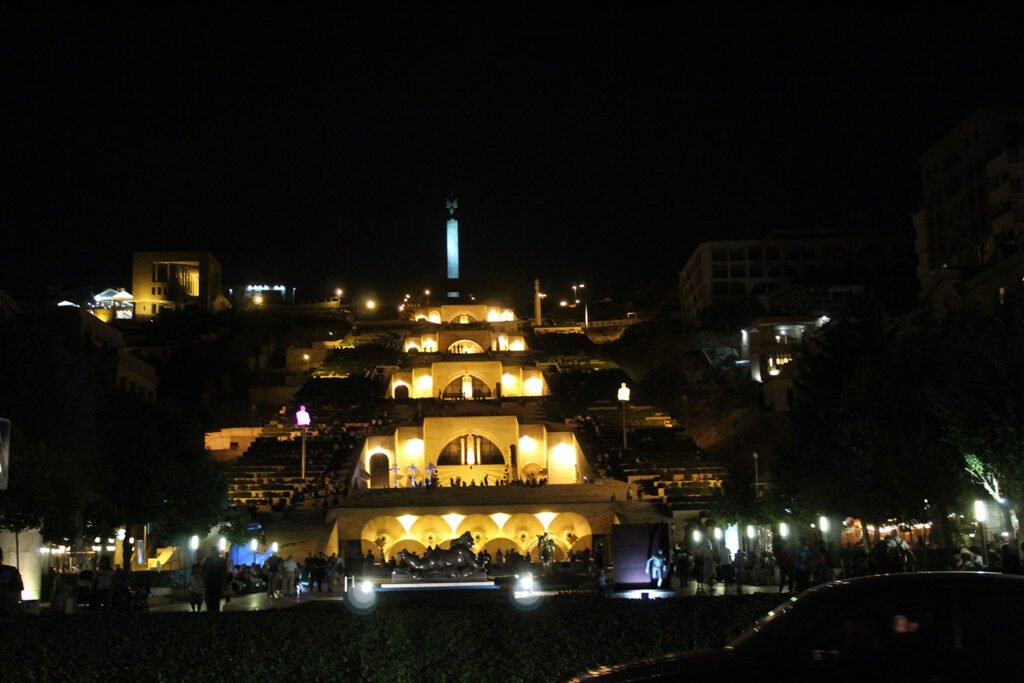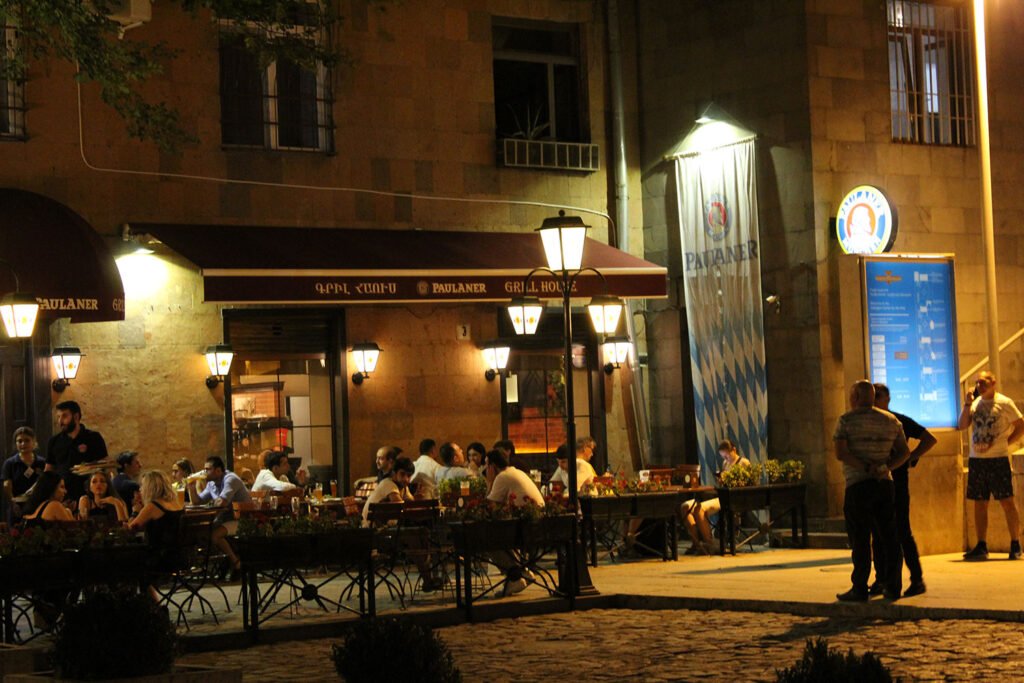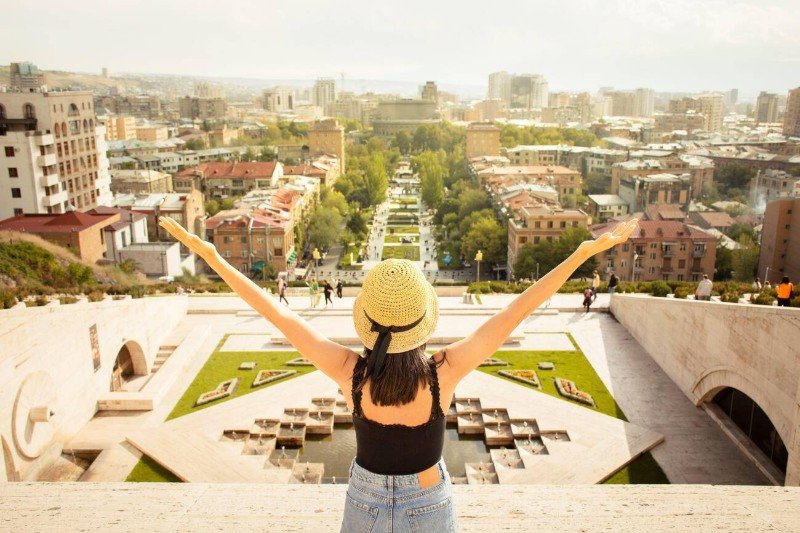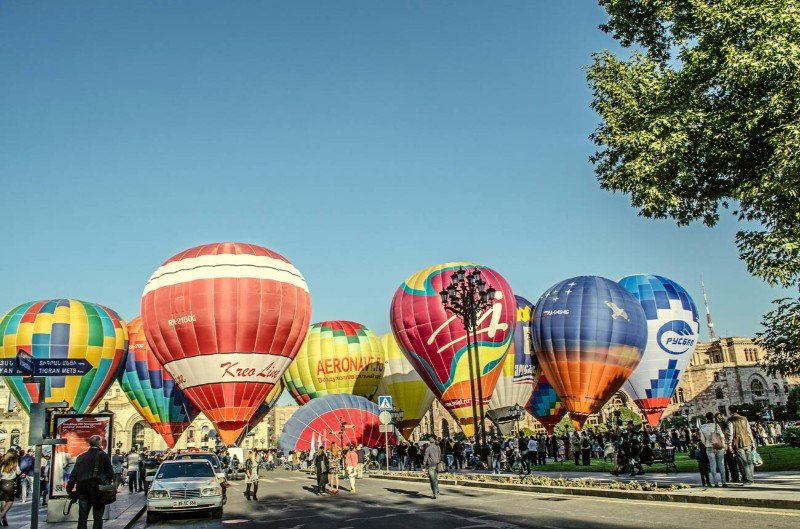Yerevan Cascade, which is also famous as the Thousand Steps, is an architectural masterpiece which is located in the heart of Yerevan city, the capital of Armenia. This impressive staircase connects downtown Yerevan to the Monument neighborhood and Victory Park. For visitors who find climbing difficult, the complex offers escalators inside, making it accessible for everyone. The interior also houses the Cafesjian Museum of Art.
Follow this article with us to learn more about its history and art collection.
Yerevan Cascade Overview

The Cascade offers a breathtaking view of Yerevan city from top of those steps, attracting tourists during the whole year, even during the cold winter months. Though summer sees the highest number of visitors, the site remains popular throughout the year. It’s a destination where people go for relaxation, peace, or simply to admire the views. Some even visit in the rain, unaffected by weather conditions.
Visitors from all walks of life find joy in the Cascade. Some see it as a place to relax, while others come for solitude or reflection. It’s a peaceful retreat for the elderly, while young couples often choose this place to have some private talks or discuss about their future plans.
With its growing popularity, the Yerevan Cascade has become a top tourist attraction, offering an experience that delights both locals and international visitors alike.
Yerevan Cascade History

Although construction began in the 1970s, the idea of connecting Monument Street with central Yerevan dates back to the Soviet era. Alexander Tamanyan, Yerevan’s chief architect, envisioned a large green space with gardens and a waterfall. While the project was delayed and almost forgotten, it was revived in the late 1970s by architect Jim Torosyan. He expanded on Tamanyan’s original idea, adding monumental staircases that make traveling through the city easier and more scenic.
Torosyan’s plans included outdoor staircases and escalators inside the structure. He also accommodated and considered green spaces and sculptures that highlight Armenia’s rich cultural heritage.
The construction of this complex began in the 1980s but encountered setbacks due to the 1988 earthquake and the dissolution of the Soviet Union in 1991. After Armenia gained independence, the project stalled due to economic difficulties. It wasn’t until 2002 that the project resumed, and the Cascade became one of Yerevan’s most iconic landmarks.
Where is Yerevan Cascade

The Yerevan Cascade is located in the city’s center, on Tamanyan Street. It’s easily accessible by public transportation, with the Yeritasardakan Metro Station just 650 meters away and Marshal Baghramyan Metro Station about 1 kilometer away. Nearby attractions include the Yerevan Opera Theater and the Matenadaran Manuscripts Museum. Republic Square is also just 1.6 kilometers from the Cascade.
Key facts about Yerevan Cascade

The Yerevan Cascade consists of 572 steps, stretching 50 meters wide and 302 meters high. From the lowest point to the top balcony, it reaches 450 meters. A large section of the complex remains unfinished, with plans for a glass museum at the top still pending completion.
Outdoor Space

The Cascade’s outdoor area is beautifully landscaped with small green spaces and colorful flower beds. Numerous sculptures, created by internationally renowned artists, adorn the area, captivating visitors.
These sculptures are not only artistically significant but also hold great financial value. Some of the most notable sculptures include works by renowned artists such as Lynn Chadwick, Barry Flanagan, and Fernando Botero.
Famous Sculptures at Yerevan Cascade
Notable sculptures at the Cascade include:
- “The Watchers” and “Sitting Couple” by Lynn Chadwick.
- “Acrobats” and “Hare Jumping Through Bell” by Barry Flanagan.
- “Roman Warrior” and “Black Cat” by Fernando Botero.
Cafesjian Museum of Art
The Cafesjian Museum of Art showcases contemporary art to visitors from around the world. It features both permanent and temporary exhibitions. Since its opening, the museum has attracted over a million visitors. Some of its most prominent galleries include:
Gallery One: Showcases works from famous glass artists like Jan Zoricak and Herb Babcock.
Kanjian and Eagle Galleries: Display private collections from notable figures in Armenian art history, including works by Robert Elibakian and Poghos Haytayan.
Sassountsy Davit Gallery: Features pieces by Czech glass artists Stanislav Libenský and Jaroslava Brychtová.
Eagle Garden and Swarovski Galleries: Present other notable collections.
You can see different art and crafts from around the world located at The museum’s shop, featuring unique items by artists like Dale Chihuly and Andy Warhol. Armenian art and craftsmanship are also well-represented.
Visiting Yerevan Cascade

The Yerevan Cascade is open 24/7 and can be visited free of charge. However, certain exhibitions inside the Cafesjian Museum require a ticket. The museum is open from Friday to Sunday, 10 AM to 8 PM.
Moreover, please note that the escalators which are located inside are operating everyday till 20:00.
Make sure to add this stunning attraction to your itinerary when visiting Armenia!





